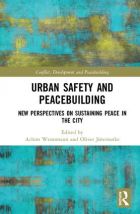Urban Safety and Peacebuilding: New Perspectives on Sustaining Peace in the City

Urban Safety and Peacebuilding investigates how to sustain peace in the city, drawing attention to the community-level origins of building peace. This question is increasingly becoming a priority in a context of rapid urbanization, and increasing risk of conflict, violence and insecurity in cities.
The volume’s chapters represent original research from diverse perspectives – including architecture, criminology, social anthropology, political science and urban studies – demonstrating advances in urban safety and peacebuilding theory and practice. These chapters are based on contributions to the Technical Working Group on the Confluence of Urban Safety and Peacebuilding Practice, an informal collective action initiative established in 2015. The various chapters provide entry points for new possibilities in terms of policies, strategies and responses to conflict, violence and exclusion in urban areas.
Innovations in this field are critical because typical responses to urban crime and violence have adopted repressive and securitized approaches, often with tremendous human cost and the tendency to exacerbate violence. Furthermore, these typical policies are rarely aligned with planning and design innovations to reshape public and semi-public spaces in a way that addresses urban vulnerabilities, crime, delinquency and antisocial behaviours. Rather, in cities with high sociospatial inequality, infrastructure and housing projects tend to lead to further social fragmentation.
Chapter 1 provides a useful starting point by exploring the commonalities, contrasts and intersections between urban safety and peacebuilding, conceptually and in practice. The chapter’s authors, Jonathan Luke Austin and Oliver Jütersonke, tease apart the intertwined concepts of “urban safety” and “peacebuilding” by providing ideal-type minimalist definitions. Urban safety is defined as urban planning to alter the material environment in order to reduce the possible hazards of the city, while peacebuilding refers to the generally more informal processes of conflict prevention, mitigation and transformation. By clearly defining and disentangling urban safety and peacebuilding, Austin and Jütersonke attempt to clarify the nature of the relationship between the two concepts (Table 1.1, page 17).
Chapter 9 concludes the volume by drawing together its main themes and reflecting on how to achieve safer and more inclusive cities. It emphasizes how urban safety and peacebuilding practice can result from practical needs to solve place-specific problems, driving participatory processes and arising within contentious political economies. Thus, it highlights how the book provides a starting point for operationalizing international agendas for fostering peaceful and inclusive cities, by highlighting a subtler process of problem-driven iterative adaptation.
Book note prepared by Kate Guo
Search the Book notes database
Our Book notes database contains details and summaries of all the publications included in Book notes since 1993 - with details on how to obtain/download.
Use the search form above, or visit the Book notes landing page for more options and latest content.
For a searchable database for papers in Environment and Urbanization, go to http://eau.sagepub.com/

